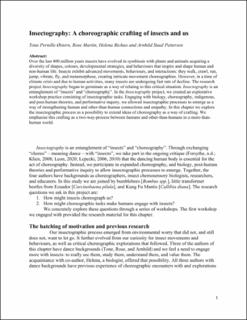| dc.description.abstract | Over the last 400 million years insects have evolved in symbiosis with plants and animals acquiring a diversity of shapes, colours, developmental strategies, and behaviours that inspire and shape human and non-human life. Insects exhibit advanced movements, behaviours, and interactions: they walk, crawl, run, jump, vibrate, fly, and metamorphose, creating intricate movement choreographies. However, in a time of climate crisis and due to human activities, many insects are undergoing fast rate of decline. The research project Insectography began to germinate as a way of relating to this critical situation. Insectography is an entanglement of “insects” and “choreography”. In the Insectography project, we created an explorative workshop practice consisting of insectographic tasks. Engaging with biology, choreography, indigenous, and post-human theories, and performative inquiry, we allowed insectographic processes to emerge as a way of strengthening human and other-than-human connections and empathy. In this chapter we explore the insectographic process as a possibility to extend ideas of choreography as a way of crafting. We emphasise this crafting as a two-way-process between humans and other-than-humans in a more-than-human world. Insectography is an entanglement of “insects” and “choreography”. Through exchanging “choreo”—meaning dance—with “insecto”, we take part in the ongoing critique (Forsythe, n.d.; Klien, 2008; Leon, 2020; Lepecki, 2006, 2010) that the dancing human body is essential for the act of choreography. Instead, we participate in expanded choreography, and biology, post-human theories and performative inquiry to allow insectographic processes to emerge. Together, the four authors have backgrounds as choreographers, insect chemosensory biologists, researchers, and educators. In this study we are joined by bumblebees [Bombus spp.], little transformer beetles from Ecuador [Carcinobaena pilula], and Kung Fu Mantis [Callibia diana]. The research questions we ask in this project are: (1) How might insects choreograph us? (2) How might choreographic tasks make humans engage with insects? We concretely explore these questions through a series of workshops. The first workshop we engaged with provided the research material for this chapter. | en_US |

